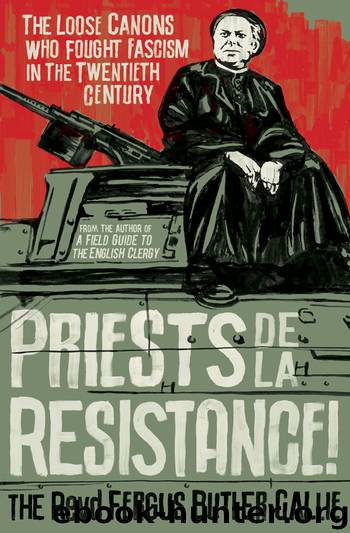Priests de la Resistance! by The Revd Fergus Butler-Gallie

Author:The Revd Fergus Butler-Gallie
Language: eng
Format: epub
Publisher: Oneworld Publications
THE NETHERLANDS
— CARDINAL DE JONG, KOENO GRAVEMEIJER & ST EDITH STEIN —
The Ecumenism of Blood
In the thin, south-eastern strip of the Netherlands that sits between Belgium and Germany there lies a town called Roermond. It was here, in this unassuming corner of the province of Limberg during the year 1888 that Jonkvrouw van Aefferden had arranged to be buried next to her husband, one Graf Colonel von Korkum, who had gone to meet his Maker eight years earlier. So far, so bourgeois. There was, however, one issue. Graf Colonel von Korkum had been a Protestant and so had been laid to rest in the town’s Protestant cemetery, with a plot next to its neat stone wall. On the other side lay Roermond’s resting place for its Roman Catholic dead. The stones of that wall represented communities that were totally separate in life, and wished to be so in death (although, of course, underground, the worms were free to dart between Catholic and Calvinist corpses, depending on what tantalised their taste buds that day). The division was such that even the wishes of the ailing Jonkvrouw couldn’t overcome it. Or so people thought. The widow duly died and was buried, not in her family vault in the centre of the graveyard, but, to the surprise of staid, convention-bound Roermond society, on the other side of the wall, just feet from her husband. The funerary monument that she commissioned was even more surprising. It consisted of two graves of equal height; from the top of each came an outstretched hand, sculpted in stone. These two hands clasp in the middle, just over the top of the neat stone wall, mocking its attempt at division and ensuring that death did not part them.
The tale might seem to have been lifted out of a collection of sentimental late nineteenth-century short stories but it serves as a convenient illustration of two points. Firstly of just how conventional Dutch society was in the period leading up to the mid-twentieth century, and, secondly, of the extent to which confessional identity divided the Dutch people, even in death. Catholics and Protestants were, with the Liberals and the Socialists, part of the ‘four pillars’ of Dutch society. They had their own political parties, their own schools, their own newspapers, their own pubs – even, as the story of the widow of Roermond shows, their own graveyards. They did not mix in private, they did not mix in public. Intermarriages, like that of the Colonel and the Jonkvrouw, were rare and attracted considerable attention. The system was known as ‘pillarisation’: a nation where sectarianism manifested itself not in hatred or violence (though prejudices undoubtedly existed) but in minding one’s own business without engagement or even proximity to those of a different identity. It would take something even more drastic than the will of Jonkvrouw van Aefferden to shake up the highly segregated Dutch society. It would, in short, take a war, and a war, at that, that was to threaten the very existence of the Dutch nation, with all its divisions and idiosyncrasies, itself.
Download
This site does not store any files on its server. We only index and link to content provided by other sites. Please contact the content providers to delete copyright contents if any and email us, we'll remove relevant links or contents immediately.
Fanny Burney by Claire Harman(26526)
Empire of the Sikhs by Patwant Singh(22974)
Out of India by Michael Foss(16791)
Leonardo da Vinci by Walter Isaacson(13181)
Small Great Things by Jodi Picoult(7019)
The Six Wives Of Henry VIII (WOMEN IN HISTORY) by Fraser Antonia(5394)
The Wind in My Hair by Masih Alinejad(5033)
A Higher Loyalty: Truth, Lies, and Leadership by James Comey(4843)
The Lonely City by Olivia Laing(4748)
The Crown by Robert Lacey(4722)
Millionaire: The Philanderer, Gambler, and Duelist Who Invented Modern Finance by Janet Gleeson(4374)
The Iron Duke by The Iron Duke(4291)
Papillon (English) by Henri Charrière(4195)
Sticky Fingers by Joe Hagan(4100)
Joan of Arc by Mary Gordon(4013)
Alive: The Story of the Andes Survivors by Piers Paul Read(3968)
Stalin by Stephen Kotkin(3875)
Aleister Crowley: The Biography by Tobias Churton(3586)
Ants Among Elephants by Sujatha Gidla(3417)
